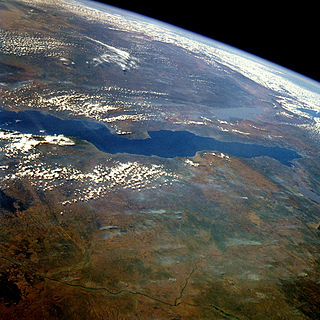
Lake Tanganyika is an African Great Lake. It is the second-largest freshwater lake by volume and the second deepest, in both cases after Lake Baikal in Siberia. It is the world's longest freshwater lake. The lake is shared among four countries—Tanzania, the Democratic Republic of the Congo, Burundi, and Zambia—with Tanzania (46%) and the DRC (40%) possessing the majority of the lake. It drains into the Congo River system and ultimately into the Atlantic Ocean.

Lake Turkana is a saline lake in the Kenyan Rift Valley, in northern Kenya, with its far northern end crossing into Ethiopia. It is the world's largest permanent desert lake and the world's largest alkaline lake. By volume it is the world's fourth-largest salt lake after the Caspian Sea, Issyk-Kul, and Lake Van, and among all lakes it ranks 24th.
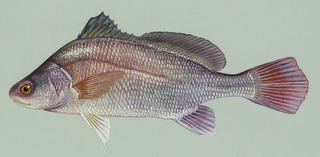
The freshwater drum, Aplodinotus grunniens, is a fish endemic to North and Central America. It is the only species in the genus Aplodinotus, and is a member of the family Sciaenidae. It is the only North American member of the group that inhabits freshwater for its entire life. Its generic name, Aplodinotus, comes from Greek meaning "single back", and the specific epithet, grunniens, comes from a Latin word meaning "grunting". It is given to it because of the grunting noise that mature males make. This noise comes from a special set of muscles within the body cavity that vibrate against the swim bladder. The purpose of the grunting is unknown, but due to it being present in only mature males and during the spawning season, it is assumed to be linked to spawning.
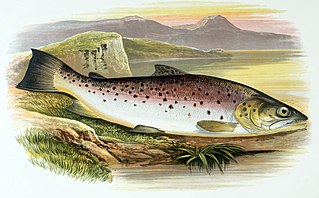
Ferox trout is a variety of trout found in oligotrophic lakes/lochs of Ireland, England, Scotland and Wales. Ferox trout is a traditional name for large, piscivorous trout, which in Scotland feed largely on Arctic char. It has been argued to be a distinct species, being reproductively isolated from "normal" brown trout of the same lakes, particularly in Ireland. However, it is uncertain whether the ferox of different lakes are all of a single origin. This fish grows to a length of 80 centimetres (31 in) SL.
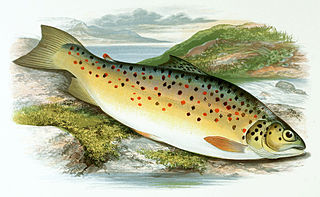
The gillaroo is a species of trout which eats primarily snails and is only proven to inhabit Lough Melvin in Ireland.
Lates longispinis, also known as the Rudolf lates or Turkana perch, is a species of latid fish that is endemic to Lake Turkana in Kenya and Ethiopia. It grows to 57 centimetres (22 in) in length. Lates longispinis is important to commercial fisheries and is also known as a gamefish. It is not known to exist in the aquarium fish trade.

Labeobarbus intermedius is an East African ray-finned fish species in the family Cyprinidae. Like the closely related yellowfish, it is hexaploid. A large species, the maximum recorded standard length is nearly 50 cm (20 in). This species has a subspecies named Labeobarbus intermedius intermedius.
The Lake Turkana barb is a species of ray-finned fish in the family Cyprinidae. It is endemic to Lake Turkana in Kenya. It is considered a Vulnerable species by the IUCN.
Pelusios broadleyi, commonly known as the Turkana mud turtle, Broadley's mud turtle, or the Lake Turkana hinged terrapin, is a species of turtle in the family Pelomedusidae. The species is native to eastern Africa.
The redfin robber is a species of fish in the family Alestidae. It is endemic to Tanzania. Its natural habitats are rivers and freshwater lakes.
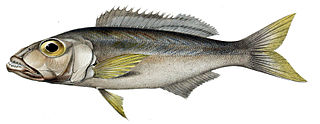
Bathybates ferox is a species of fish in the family Cichlidae. It is found in Burundi, the Democratic Republic of the Congo, Tanzania, and Zambia. Its natural habitat is Lake Tanganyika where it lives in shallow water and is exclusively piscivorous. The IUCN has assessed it as being a "least-concern species".

Brycinus is a genus of ray-finned fish in the family Alestiidae. Like other "African characids", they were formerly included in the Characidae but are actually somewhat more distantly related Characiformes.
The striped robber is a species of fish in the family Alestidae. It is found in Angola, Botswana, Malawi, Mozambique, Namibia, South Africa, Zambia, and Zimbabwe. Its natural habitats are rivers and inland deltas.
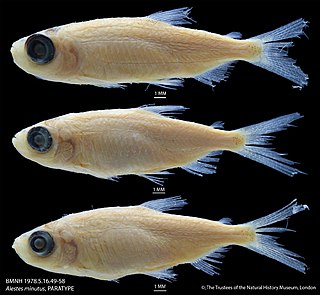
The dwarf Lake Turkana robber is a species of fish in the family Alestidae. It is endemic to Lake Turkana in Kenya.
Brycinus rhodopleura is a species of fish in the family Alestidae. It is endemic to Tanzania. Its natural habitats are rivers and freshwater lakes. They are known for being in Lake Tanganyika and the Malagarazi River.
Sadler's robber is a ray-finned fish species in the family Alestidae.

Ictinogomphus ferox, commonly called the common tiger or the common tigertail, is a species of dragonfly in the family Gomphidae. It is found in Angola, Botswana, Central African Republic, the Democratic Republic of the Congo, Ivory Coast, Ghana, Guinea, Kenya, Liberia, Malawi, Mozambique, Namibia, Nigeria, Senegal, Somalia, South Africa, Tanzania, Togo, Uganda, Zambia, Zimbabwe, possibly Burundi, and possibly Ethiopia. Its natural habitats are subtropical or tropical moist lowland forests, dry savanna, moist savanna, subtropical or tropical dry shrubland, subtropical or tropical moist shrubland, rivers, intermittent rivers, shrub-dominated wetlands, swamps, freshwater lakes, intermittent freshwater lakes, freshwater marshes, intermittent freshwater marshes, and freshwater springs.

Labeobarbus bynni, the Niger barb, is an African species of cyprinid freshwater fish. It has often been placed in the genus Barbus, but is now usually placed in Labeobarbus. This is a relatively large barb, up to 82 cm (32 in) in total length. It is caught as a food fish, but catches can vary greatly from year to year.

Primarily known as long-fin tetra, Brycinus longipinnis is also called the African long-finned tetra among other common names.

The Lake Turkana sardine is an African species of freshwater fish in the family Cyprinidae. It is found in the Nile River and Webi Shebeli, and in the Niger, Bénoué and Volta basin.













